Commission, July 24, 2015, No M.7632
EUROPEAN COMMISSION
Judgment
NOKIA/ ALCATEL-LUCENT
Dear Sir/Madam,
Subject: Case M.7632 NOKIA/ ALCATEL-LUCENT
Commission decision pursuant to Article 6(1)(b) of Council Regulation No 139/20041 and Article 57 of the Agreement on the European Economic Area2
(1) On 19 June 2015, the European Commission (the "Commission") received notification of a proposed concentration pursuant to Article 4 of the Merger Regulation by which Nokia Corporation ("Nokia" or the "Notifying Party") will acquire sole control within the meaning of Article 3(1)(b) of the Merger Regulation over Alcatel-Lucent S.A. ("Alcatel") by way of a public offer (the "Transaction"). Nokia and Alcatel are collectively referred to as "Parties".
1.THE PARTIES
(2) Nokia is a global provider of mobile network equipment and networks service platforms, active also in the provision of professional services to telecommunications network operators and service providers. Nokia's network equipment activities have a geographic focus in the European and Asian markets.
(3) Alcatel is active in the provision of fixed and mobile network equipment, as well as related services to telecommunications network operators worldwide. Alcatel's activities are mainly focused on the North American continent.
2.THE CONCENTRATION
(4) Pursuant to the Memorandum of Understanding entered into between the Parties on 15 April 2015, Nokia will launch public tender offers for Alcatel's shares in France and in the United States. Following the completion of these offers, Nokia will own between 50% and 100% of Alcatel's shares.
(5) Following the tender offers, Nokia expects to acquire more than 50% of Alcatel's shares. The remaining shareholders will likely continue to be widely dispersed.3 Even if, post-transaction, Nokia would hypothetically acquire a shareholding of only 50.1%,4 pursuant to Alcatel's governance documents post-transaction Nokia would have enough votes to adopt any ordinary shareholder resolution, such as, inter alia, appointment and dismissal of the board members, (directly or indirectly) appointment and dismissal of other senior management and overall strategic commercial decisions of the company, including approval of the business plan and budget. Therefore, Alcatel will be subject to sole control by Nokia.
(6) The Transaction constitutes therefore a concentration within the meaning of Article 3(1)(b) of the Merger Regulation.
3.EU DIMENSION
(7) The undertakings concerned have a combined aggregate world-wide turnover of more than EUR 5 000 million (Nokia: EUR 12 732 million; Alcatel: EUR 13 177 million). Each of them has an EU-wide turnover in excess of EUR 250 million (Nokia: EUR […] million; Alcatel: EUR […] million), but they do not achieve more than two-thirds of their aggregate EU-wide turnover within one and the same Member State. The Transaction therefore has an EU dimension.
4.RELEVANT MARKETS
(8) The Transaction combines two global providers of telecommunications network equipment and related services resulting in horizontal overlaps mainly in the markets for the provision of (i) Radio Access Network ("RAN") equipment; (ii) Core Network Systems ("CNS") solutions; and (iii) network-related services. A possible vertical link between the activities of the Parties has also been identified within CNS solutions.
1.1.RAN equipment
(9) RAN equipment provides the radio functions of the mobile network by transmitting signals between the mobile handset and the core portion of the mobile network. Therefore, the RAN has an open interface to mobile end-user devices and to the CNS.
(10) RAN equipment can be grouped into standard generations (2-2.5G, 3G, 4G and the future 5G). The most recent technology generation is 4G, currently actively deployed by operators both in Europe and in the US. 3G, while still being widely used and to some extent rolled-out, is considered a mature technology given that in many countries 3G networks have already been deployed for quite some time and have reached a coverage of over 95% in the EEA.5 2-2.5G is regarded as a legacy technology.
(11) 2G systems support primarily voice services, but also basic data transmission such as text messaging. 2G standards include GSM, CDMA, iDen and PDC technologies. 2.5G systems are overlays on 2G systems and do not fundamentally change the network structure, but allow better delivery of data information. 2.5G includes GPRS and EDGE technologies. As explained in paragraph (10), 2G-2.5G networks are very mature technologies, and today represent only a small portion of total network infrastructure revenue, given that 2G networks are no longer being rolled out and revenues from 2G equipment mainly stem from maintenance.
(12) In the EEA, 3G systems include primarily WCDMA/ UMTS technology.6 Other 3G technologies include CDMA 1x EV-DO, which is used predominantly in the U.S., Canada, South Korea, Mexico, India, Israel, Australia, Venezuela and China, and was used only to a very limited extent in the EEA. TDSCDMA is a variant of 3G technology that is only used in China. As explained in paragraph (10), 3G is also considered a mature technology.
(13) 4G systems refer to the latest generation of wireless network currently in the market. 4G includes Long Term Evolution (LTE) technology that is used for data transmission, VoLTE (Voice Over LTE) and WiMAX.7 4G systems most typically refer to networks utilizing LTE. Currently, many operators are rolling out LTE networks, but continue to run voice services over 3G portions of their network, although some operators are beginning to shift to VoLTE to carry voice services over LTE and an IP-based core.
(14) Analyst forecasts foresee 4G RAN equipment sales (and related expenditure of mobile operators) to increase worldwide, corresponding to a steady decline of sales of RAN equipment supporting other technologies, as shown by Figure 1 below.
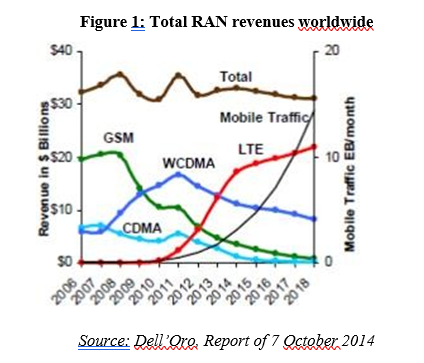
Figure 1: Total RAN revenues worldwide
(15) 5G systems constitute the next phase of mobile telecommunication standards beyond the current 4G standards. However, 5G is still in the development phase and no standards have yet been adopted to define 5G technologies.
(16) While in the past, network equipment was technology specific, more recently, there is also another type of equipment technology, the so-called Single RAN ("SRAN") technology, which allows mobile operators to run and operate multiple mobile telecommunication standards on a single network. SRAN is commonly defined as a radio portfolio, which supports simultaneous usage of 2G (GSM), 3G (UMTS) and 4G (LTE) radio technologies. Single RAN is not standardized and equipment vendors offer different features under the Single RAN banner. Currently many operators in Europe are transitioning towards SRAN. While Nokia provides SRAN solutions, Alcatel-Lucent does not provide this type of equipment.
(17) Another recent technological development is the emergence of the so-called "small cells" technology, deployed mainly in densely populated areas to provide data traffic offloading. Individual geographic areas covered with mobile radio equipment are known as "cells" or "macro cells", as the coverage they provide can have a radius range of few tens of kilometres. By contrast, small cells have a radius of between 10 meters to 1 or 2 km. Small cells can be used to provide in-building and outdoor wireless service. At present, the small cells segment remains relatively small, but it is expected to grow over the next few years.
(18) RAN equipment is typically purchased through tender procedures. In some cases the bidding process is designed for a “single winner” and in other cases the offer is split between two and sometimes even three vendors. Investment cycles are relatively long, in particular for large roll-out projects. Large roll-out projects are typically tendered in a frame contract which already specifies prices and discounts. In the execution phase, specific purchase orders are issued under the terms of the contracted framework. The typical duration of frame contracts is three years which would typically involve an initial order without further purchase commitments. Mobile operators usually refresh their whole network every 3-5 years. Important tenders are also launched when there is a technology change: this can have disruptive effects on providers positioning (market share) at worldwide or regional level. Tenders are launched also for legacy technology for maintenance purposes and gap-filling of current networks.
4.1.1.Relevant product market
(19) The Commission investigated the relevant mobile telecommunication equipment markets in the Nokia/Siemens8 and Nokia/Motorola9 cases. In Nokia/Siemens the Commission considered that RAN and CNS could constitute separate product markets, given that the interchangeability of mobile network products is not equivalent within each product category.10 However, it ultimately left the precise product market definition open. Moreover, in Nokia/Siemens the Commission also found evidence that a further segmentation according to technology (GSM/GPRS/EDGE, CDMA and W-CDMA) could be made within RAN. However, it ultimately left the precise product market definition open.11 In Nokia/Motorola the exact product market definition was also left open.12
(20) The Notifying Party submits that the relevant product market definition can be left open as the Transaction in the Notifying Party's view does not give rise to any competition issues regardless of the product market definition adopted.
(21) As regards a possible segmentation based on equipment technology, the majority of the customers who replied to the market investigation in this case do not consider RAN equipment based on 2-2.5G, 3G and 4G standards substitutable in terms of functionalities offered. Some customers explain that different generations of equipment offer different functionalities (for example, 2G offers voice and basic data services, 3G offers voice and enhanced data services, while 4G offers mainly data services, which are further enhanced compared to 3G). Another customer further explains that, although 2-2.5G and 3G equipment can be updated to some extent, they cannot offer the same performance/cost ratio as network equipment supporting newer technologies.13 In turn, the majority of competitors confirm the lack of supply-side substitutability between equipment belonging to the different types of telecommunications standards.14
(22) As regards SRAN equipment, approximately half of the customers who replied to the market investigation consider the functionalities of SRAN to be the same as RAN equipment based on one single standard (2-2.5G, 3G or 4G). However, a large group of customers consider the functionalities of SRAN and RAN equipment based on one single standard not to be the same. One customer states that only a SRAN approach allows a cost efficient migration of traffic from legacy generation to the newer generations of radio protocols. Moreover, the majority of customers explain that, while the initial investment required with SRAN may be higher, in the long term SRAN functionalities are better in terms of efficiency than those of RAN equipment based on one single standard. Several customers also emphasize that SRAN is also better in terms of flexibility, as it allows the operators to decide how many RAN resources to dedicate to the different technologies, having the possibility of switching off old technologies and dedicating resources to the new ones.15 In terms of supply-side substitutability between SRAN and the equipment belonging to each of the various telecommunications standards, the market investigation was not conclusive.16
(23) As regards small cells, the majority of customers who replied to the market investigation do not consider small cells substitutable to macro cells in terms of functionalities offered. Moreover, the majority of such customers also consider that there is a significant difference in terms of cost for roll-out and maintenance for macro and small cells. Several customers emphasize the complementary character of small cells and macro cells: small cells provide less coverage, being suitable therefore for small geographic areas. However, their installation and deployment cost is also lower. Macro cells require a higher initial investment, but they offer wider network coverage, being suited therefore for larger geographic areas. Some customers further state that the functionalities of small and macro cells could be the same, but that the coverage and the in-building penetration are different.17
(24) In the light of the above, the Commission considers that the RAN equipment market may be segmented by technology standards and/or between macro-cells and small-cells equipment. Moreover, it cannot be excluded that SRAN equipment may constitute a separate market segment. However, as the Transaction will not give rise to serious doubts as to its compatibility with the internal market under any plausible market definition, the question of the exact scope of the relevant product market can be left open.
4.1.2.Relevant geographic market
(25) As regards the geographic scope of the RAN equipment market (and its possible segments), in Nokia/Siemens the Commission had evidence that the market for mobile network equipment, including RAN, is at least EEA-wide if not global, but ultimately left the exact geographic definition open.18 In the Nokia/Motorola case the geographic market definition was also left open.19
(26) The Notifying Party submits that the relevant geographic market for mobile network equipment, including RAN, is global in scope due to several factors including: (i) international standardization of mobile telecommunications network equipment; (ii) vendor and industry interoperability initiatives through Interoperability Testing Centers (“IOTs”); (iii) contracts that are competed on a global basis – there is no longer a concept of ‘home’ market or region; (iv) worldwide shipping and limited transport costs; (v) limited regional variations in cost and price; and (vi) liberalized downstream service markets leading to open upstream equipment markets.
(27) The Notifying Party also submits that RAN vendors are multinational firms with worldwide presence that bid on opportunities at a global level. A number of customers are international companies or have global parents, which, according to the Notifying Party, sometimes take advantage of their global scale of operations. Moreover, in the Notifying Party's view, the global scope of the relevant market(s) is not put into question by differences in relative market positions of RAN equipment vendors in different regions of the world. According to the Notifying Party, market shares in any particular region are not necessarily indicative of actual competition at regional or global basis, given the nature of the downstream market. In this respect, the Notifying Party submits that the fact that there are differences in relative market positions of suppliers in different regions of the world reflects the purchasing dynamics and does not suggest that there are separate geographic markets with differing competitive characteristics.
(28) The majority of the customers who replied to the market investigation submit that their activities are limited to the EEA only and therefore they do not have a view on possible differences in price, technology or footprint of different vendors for the supply of RAN equipment in the EEA and other parts of the world.
(29) As regards prices, several customers state that in general prices for RAN equipment are the same for EEA and other regions.20
(30) As regards technology, several customers point to SRAN being the preferred technology in Europe as opposed to the rest of the world. Moreover, the technology standards and radio frequencies (spectrum) used may also differ across different regions.21
(31) As regards vendors’ footprint, several customers submit that all vendors have worldwide footprint, but that their strength varies across regions.22
(32) The majority of competitors who replied to the market investigation confirm that they are active in the supply of RAN equipment worldwide. There are, however, certain regions of the world where some vendors do not actively compete: Chinese vendors, despite their global presence, are not active in the United States, given the latter's security concerns.23
(33) As regards prices, the majority of competitors also state that their prices are not homogeneous worldwide due to the different requirements of mobile operators.24 As regards technology, half of the competitors state that the technology and standards are global and that, as products are developed supporting telecommunication standards, no difference among regions exists. The other half of the competitors, however, considers that differences in terms of technological development exist between regions. In particular, one competitor submits, that although the products are based on global telecommunication standards, customers have very specific requirements for the products to be included in their networks.
(34) As regards differences in customer preferences between the EEA and other regions, the majority of competitors confirm that these differences exist. Several competitors point to SRAN as being typically requested by all customers in the EEA.25 The large majority of competitors also confirm the existence of differences in terms of applicable regulation and legal requirements between the EEA and other regions of the world (for example US operators require security certificates).26
(35) In any event, the exact geographic scope of the RAN equipment market and its possible segments and, in particular, whether such scope encompasses only the EEA or is worldwide, can be left open, as the Transaction will not give rise to serious doubts as to its compatibility with the internal market under any plausible market definition.
4.2.CNS solution
(36) CNS solutions includes the following main elements: (i) wireless packet core equipment; (ii) carrier IP telephony solutions; and (iii) operation and business support software ("OSS/BSS").27
(37) The wireless packet core sits between the RAN portion of the network and the Internet Protocol ("IP") network of the operator enabling the delivery of voice and data traffic to and from the mobile handset of the user. There are two types of packet core equipment: (a) Traditional Packet Core used in 2G and 3G network28 and (b) Evolved Packet Core used in 4G networks.
(38) The architecture of the Traditional Packet Core consists of the following four main elements: (i) Gateway GPRS Support Node ("GGSN") responsible for the interworking between the GPRS network and external packet switched networks such as the Internet; (ii) Serving GPRS Support Node ("SGSN") responsible for the routing, transfer and delivery of data packets from and to the mobile stations within its geographical service area; (iii) Packet Data Serving Node ("PDSN") which is specific to CDMA mobile networks and serves as the connection point between RAN equipment and IP networks; and (iv) Access Service Network ("ASN") Gateway which controls and aggregates traffic from WiMAX base stations.29
(39) The Evolved Packet Core has two main components: (i) Mobility Management Entity ("MME") which fulfils the role of a control and signalling node that manages session states and authenticates and tracks a user across the networks; and,(ii) Packet Data Node Gateway ("PGW") which is the interface between 4G LTE network and other packet data networks such as the Internet.
(40) In general, network operators purchase the wireless packet core equipment as a complete solution from one vendor. However, the sub-components of the wireless packet core30 can be purchased independently thanks to the standardised interfaces between the different sub-components.
(41) Carrier IP telephony solutions enable the transmission of real-time voice over the Internet or over an IP network via Voice over Internet Protocol ("VoIP") and via the emerging VoLTE. Certain Carrier IP telephony solutions can enable the delivery of multimedia services such as voice calls, messages and file sharing. Similar to the wireless packet core, Carrier IP telephony products are typically purchased as a complete solution from one vendor. However, given that its components and sub-components31 are standardised, purchasing these components from different vendors is not unusual for operators that seek to optimise the technical aspects of their networks to suit their specific needs.
(42) OSS/BSS: the proper technical and commercial operation of a network requires the use of Operations Support System ("OSS") software which allows operators to manage, monitor and control network operations and services, as well as the use of Business Support System ("BSS") software enabling operators to carry out the business-related functions, such as billing, charging and subscriber management functions.
(43) OSS interfaces (and in particular to the so-called northbound interfaces "NBI" that allow for a given network component to communicate with a higher-level component) describe the network status information generated by the macro cells and the other radio network elements. This status information is an input for the optimization of the network which is achieved through another software solution, the Self-Organizing Network ("SON") software. SON solutions provide network with the ability to quickly and autonomously optimize itself. Two types of SON software exist: distributed SON and centralised SON.
(44) Distributed SON consists in distributed or decentralized software solutions which are integral part of the OSS software. Such solutions are only offered by OSS vendors and they do not typically have multi-vendor capabilities, i.e. they cannot be deployed and run on every network.
(45) Centralised SON ("C-SON") consists of software solutions that "sit" with central equipment controlling the entire network and constitute an "add-on" rather than an integral part of the OSS software. C-SON solutions are provided also by non-OSS vendors and these solutions have multivendor capability.
(46) As status information generated by the OSS is an input for the operation of SON, and in particular C-SON solutions, a vertical link exists between OSS and SON/C- SON.
(47) CNS solutions are typically purchased through tender procedures similar to those described at paragraph (18) above.
4.2.1. Relevant product market
(48) As explained in paragraph (19) above in its Nokia/Siemens decision, the Commission considered, that in view of the fact that RAN and CNS equipment can be purchased entirely independent from one another, CNS and RAN equipment could constitute separate product markets.32 The Commission left the precise market definition open in this respect both in the Nokia/Siemens and Nokia/Motorola decisions.33
(49) In Nokia/Siemens,34 the Commission also considered possible segmentations within CNS solutions: a possible subdivision of the Traditional Packet Core into circuit- based and packet-based switching products along with a possible further subdivision of the packet-based switching products into Serving GPRS Support Nodes (SGSN) and Gateway GPRS Support Nodes (GGSN), but ultimately left the exact market definition open.
(50) Since Nokia/Siemens the industry has transitioned to the newer 4G technology, whose network functionalities revolve around an Evolved Packet Core, which no longer distinguishes between circuit-core and packet-core, but treats all voice and data as packets. The Commission has not yet analysed the exact scope of the relevant product market/s in relation to either Evolved Packet Core equipment or Carrier IP telephony products.
(51) In relation to OSS/BSS, in Nokia/Siemens, the Commission considered a possible distinction between OSS and BSS,35 but ultimately left the exact product market definition open.
(52) The Notifying Party submits that the relevant product market definition can be left open as the Transaction in the Notifying Party's view does not give rise to any competition issues regardless of the product market definition adopted.
(53) As regards the wireless packet core the majority of customers who replied to the market investigation consider that the two types of wireless packet core, that is to say the Traditional Packet Core and the Evolved Packet Core, are not substitutable in terms of functionalities. Respondents explain that the Traditional Packet Core is meant to support 2-2.5G and 3G services while the Evolved Packet Core supports 2-2.5G, 3G and in addition 4G services thus performing the legacy functionalities of the Traditional Packet Core on top of the new 4G functionalities. The majority of competitors who replied to the market investigation confirm the lack of supply-side substitutability between the Traditional Packet Core and the Evolved Packet Core.36
(54) Customers also unanimously state that the node components of the Traditional Packet Core (GGSN and SGSN) have entirely different functionalities (SGSN is setting up the mobile data connectivity while GGSN is a gateway and handles the mobile data traffic) and cannot be substituted with one another.37 As regards the two components of the Evolved Packet Core (MME and PGW) the vast majority of customers consider these two building blocks to cover different functionalities (similarly to the roles played by the GGSN and SGSN in the Traditional Packet Core, the MME is setting up the mobile data connectivity and the PGW is handling the throughput).38 The majority of competitors consider that there is no substitutability from the supply side between GGSN and SGSN and between MME and PGW.39
(55) Regarding Carrier IP telephony solutions the large majority of customers consider that the different Carrier IP telephony products (Softswitches, Media Gateways, SBC, VAS, IMS Core) are not substitutable in terms of functionalities offered. Most competitors also confirm that there is no supply-side substitutability between these products.40
(56) As regards substitutability between Softswitch wireline and Softswitch wireless and between Media Gateway wireline and Media Gateway wireless, the large majority of customers consider that the functionalities of wireline and wireless products are quite different. A respondent explains that Media Gateway products are tightly coupled with the corresponding Softswitches and that, since Softswitches are not substitutable between wireline and wireless, Media Gateway wireline products and Media Gateway wireless are also not substitutable.41 The majority of competitors also consider that there is no substitutability between the wireline and wireless Media Gateway and Softswitch from the vendor's perspective.42
(57) IMS CSCF and IMS HSS, which are the two main components of the IMS Core, are also considered not substitutable between each other due to their different functionalities by all customers who replied to the market investigation. Customers explain that IMS CSCF, which handles call session control, is a different logical entity from IMS HSS, which is the user database and both IMS CSCF and IMS HSS are necessary to provide VoIP services. Some respondents state that it is possible to have different vendors for CSCF and HSS despite the interoperability issues that may arise. A number of competitors also consider that there is no supply-side substitutability between CSCF and HSS.43
(58) The large majority of both customers and competitors who replied to the market investigation consider that there is a clear distinction between distributed or decentralized SON solutions, which are integral part of the OSS software, do not have a multivendor capability and are offered by OSS vendors, and the centralized C-SON solutions, which are more of an "add-on" to the OSS and can be provided by non-OSS vendors.44 A significant number of customers point out that they have not purchased or do not need a C-SON solution. Based on the replies of those customers who purchased C-SON solutions, it appears that customers purchase such solutions sometimes together and sometimes separately from RAN and/or CNS equipment.45
(59) In any event, for the purpose of this decision, the Commission considers that the exact product market definition, and in particular whether a distinction should be made between (i) wireless packet core, including a possible segmentation into Traditional Packet Core and Evolved Packet Core and a further sub-segmentation of these two products into SGSN and GGSN and into MME and PGW respectively; (ii) Carrier IP telephony products, including a possible segmentation of these products into Softswitch products (and their further segmentation into wireless and wireline), Media Gateway products (and their further segmentation into wireless and wireline), SBC, VAS, IMS Core (including further segmentation into CSCF and HSS); and (iii) OSS/BSS including whether decentralised and centralized SON solutions constitute separate markets or market segments, can be left open as the Transaction will not give rise to serious doubts as to its compatibility with the internal market under any plausible market definition.
4.2.2. Relevant geographic market
(60) As regards the geographic scope of the CNS market (and its possible segments) in Nokia/Siemens46 and in Nokia/Motorola47 the Commission considered the scope to be at least EEA-wide, if not global, but left the exact geographic market definition open.
(61) The Notifying Party submits that all relevant markets for CNS equipment should be considered global in scope.
(62) The majority of customers who replied to the market investigation submit that their activities are limited to the EEA only and therefore they do not have a view on possible differences in price, technology or footprint of different vendors for the supply of wireless packet core and/or Carrier IP telephony solutions for other parts of the world. However, among the customers who replied to the relevant question, the majority considers there are no significant differences between the EEA and other parts of the world in terms of prices, technologies48 and footprint of vendors.49
(63) The majority of the competitors who replied to the market investigation confirm that they are active in the provision of Wireless Packet Core and Carrier IP telephony solutions at worldwide level. Notwithstanding the global presence of these vendors, there are certain regions of the world where they do not actively compete. For example, Chinese vendors, who have a strong domestic footprint and an important position globally, are not present in the United States.50 As regards prices, the majority of competitors also state that their prices are not homogenous worldwide.51 Finally, as regards technology, the results of the market investigation suggest that technological differences exist based on the different generation of cellular standards deployed in a certain region (4G roll-out is not equally advanced worldwide).52
(64) In any event, the exact geographic scope of the relevant markets, and in particular whether their scope encompasses only the EEA or is worldwide, can be left open, as the Transaction will not give rise to serious doubts as to its compatibility with the internal market under any plausible market definition.
4.3. Network Infrastructure Services
(65) There are two types of network infrastructure services related to RAN equipment and CNS solutions: (i) network implementation and care services, closely connected to the supply of network equipment, and covering functions like deployment, installation and maintenance of network equipment, software support, etc.; and (ii) professional services, which include managed services,53 network planning, optimization and system integration services.
4.3.1. Relevant product market
(66) In its previous decisions in Nokia/Siemens and Nokia/Motorola, the Commission considered a distinction between Deployment, Delivery and Installation ("DDI") services and Maintenance and Care ("M&C") services, leaving the precise scope of the relevant product market open. Nothing in the course of the investigation in this case justifies a deviation from these findings.
(67) In any event, also in the case at hand, the exact product market definition can be left open as the Transaction will not give rise to serious doubts as to its compatibility with the internal market under any plausible market definition.
4.3.2. Relevant geographic market
(68) As regards the geographic dimension of the market, in its previous decisions, the Commission considered this market to be at least EEA-wide and possibly global, but left the exact geographic market definition open. Nothing in the course of the investigation in this case justifies a deviation from these findings.
(69) In any event, also in the case at hand, the Commission considers that the exact geographic market definition can be left open as the Transaction will not give rise to serious doubts as to its compatibility with the internal market under any plausible market definition.
5.COMPETITIVE ASSESSMENT
5.1.Affected Markets
(70) The Parties' activities horizontally overlap in a possible overall market for the provision of mobile network equipment (comprising both RAN and CNS solutions), giving rise to possible affected markets at worldwide level (combined market share: [20-30]%; Nokia [10-20]% and Alcatel [10-20]%) and at EEA level (combined market share: [20-30]%; Nokia [20-30]%; and Alcatel [5-10]%).
(71) With specific respect to RAN equipment and its possible segments, the Parties' activities horizontally overlap both worldwide and in the EEA and give rise to several affected markets and market segments as shown by the below Table 1.
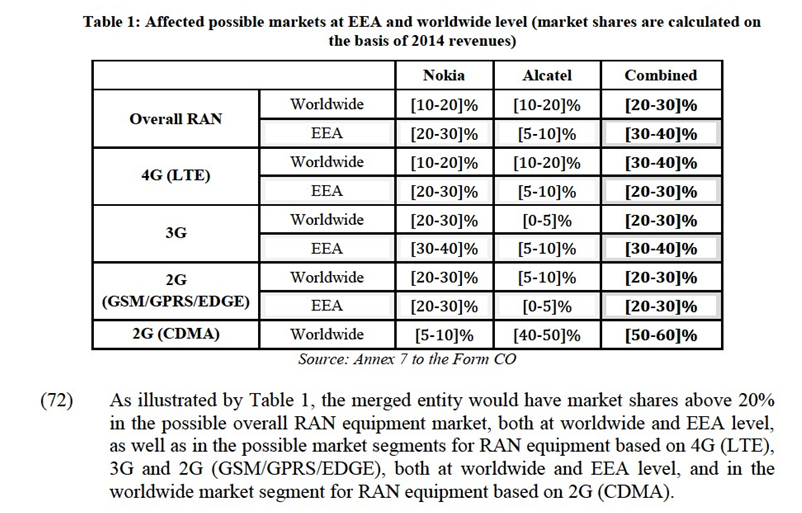
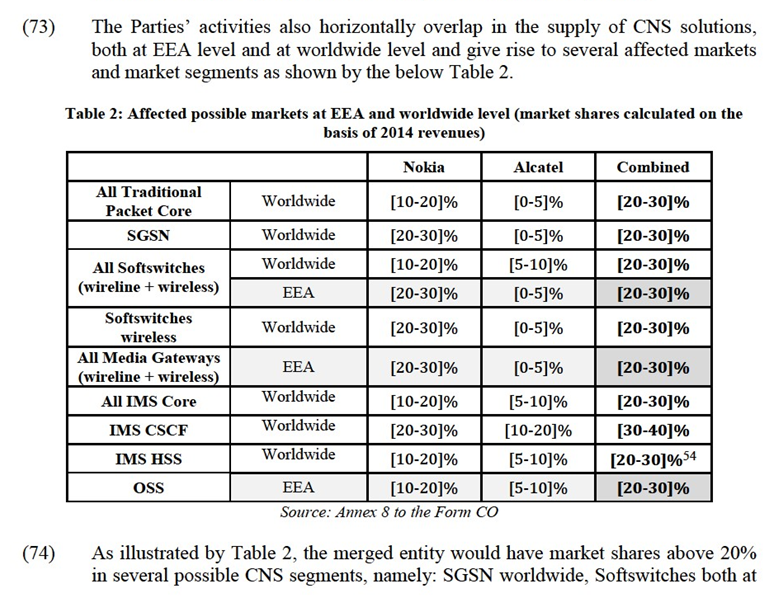
worldwide and in the EEA, Softswitches wireless worldwide, all Media Gateways in the EEA, and IMS Core, IMS CSCF and IMS HSS worldwide.
(75) Although the Parties' combined market shares in the possible C-SON market would be below 20% (both at worldwide and EEA level), this possible market would be technically vertically affected in view of the relationship explained in paragraph(46) above.
5.2. RAN equipment
5.2.1.Notifying Party's view
(76) The Notifying Party claims that the Transaction will not give rise to competition concerns at the EEA or worldwide level for the following reasons: (i) post-merger an important number of major global competitors like Ericsson, Huawei and ZTE will remain active; (ii) the RAN markets are bidding markets with fierce competition and customers in the face of telecommunication operators have considerable buyer power; (iii) at present all meaningful competition takes place only in relation to 4G LTE and the future transition to 5G will provide the opportunity to smaller players to increase their presence; and (iv) the focus of the Parties' activities is on different geographic areas (North America for Alcatel and Europe and Asia for Nokia).
(77) In particular, the Notifying Party submits that the Transaction will not reduce technology or innovation competition for RAN equipment. According to the Notifying Party, the ability to innovate is key in the wireless network infrastructure industry, which is rapidly evolving from a hardware-based to a software-and cloud- based technology. Therefore, the Notifying Party submits that, post-transaction, the merged entity as well as all competitors would keep a strong incentive to innovate.
(78) The Notifying Party also states that at present all meaningful competition takes places only in relation to 4G LTE. According to the Notifying Party, while the more mature 2G and 3G technologies such as GSM, CDMA, and WCDMA are still in use, wireless operators have shifted to new 4G LTE solutions. As a consequence, revenues in relation to 2G and 3G are mainly limited to sales to existing customers. Moreover, since 2013 Alcatel has started to refocus itself as a specialist in IP networking, cloud and ultra-broadband access and will no longer actively invest in what it views as legacy technology. Moreover, the Notifying Party claims that any assessment of RAN competition must take into account the fact that in future competition will take place for 5G systems, which has not yet been commercialized.
(79) Moreover, the Notifying Party claims that competition between RAN vendors is fierce, large wireless telecommunications operators with substantial buyer power playing RAN vendors off against one another, through bidding processes typically characterized by the lack of transparency in price levels, as well as lack of transparency in the identity of competing bidders.
(80) In addition, the Notifying Party submits that disruptive technologies currently emerging in RAN, such as Network Function Virtualization ("NFV") and Cloud- based RAN ("C-RAN") solutions provide opportunities for new and adjacent players to enter the RAN space. The Notifying Party mentions as an example that LTE RAN start-up Altiostar and Cisco have partnered to offer C-RAN solutions.


ZTE's presence among the main suppliers of RAN equipment worldwide and do not consider it as only a regional player.55
(87) As regards Samsung, its small market share in the overall RAN equipment market does not fully reflect the competitive importance of its offering and mainly depends on the fact that Samsung started offering 4G equipment outside Korea later than its competitors. Samsung has been gaining footprint in 4G equipment and, according to the data provided by the Notifying Party based on Dell'Oro Report, its revenues related to worldwide sales of RAN equipment have been steadily growing in the last years, corresponding to an increase of [60-70]% (comparing 2012 revenues with 2014 data). Samsung is expected to have an important offering for 5G equipment. Indeed it is expected that Samsung will play an active role in the first deployment of this technology in South Korea (once its standards will be defined). This has been confirmed by the respondents to the market investigation, who explained that it is expected that Samsung will increase its presence in the EEA both in 4G equipment and, in particular, in 5G equipment, when this technology will be developed.56 The Parties' internal documents describe Samsung as a "threat- e.g. to pricing and disruptive tenders with financial muscles-," with a "strong presence in key large customers (KDDI, Sprint, Reliance)" worldwide.
(88) Second, the Parties do not appear to be close competitors. This is in particular because of the different geographic focus of their RAN businesses. Indeed, as shown by the above Table 3, Nokia has a strong presence in EEA, while Alcatel has only a [5-10]% market share. Market shares figures related to other regions of the world similarly show that the Parties' geographic presence is complementary, with Alcatel being strong in markets where Nokia has less than [10-20]% market share, and vice versa. For example, the figure below shows the Parties' positioning in North America ("NAM") and Asia and the Pacific region ("APAC") with regard to 4G (LTE) RAN equipment.
Figure 2: Competitive landscape in NAM and APAC, 4G (LTE) RAN equipment, second quarter 2014
[…]
(89) The fact that the Parties are not close competitors has been confirmed by the results of the market investigation and by the review of the Parties’ internal documents. Indeed, the majority of customers responding to the market investigation consider the Parties not to be close competitors at worldwide level: in their view, Nokia's and Alcatel's offerings focus their activities to different network segments and network elements. Several customers also point to the different geographic focus of Alcatel's and Nokia's activities.57 The Parties' internal documents show that, although they monitor the competitive activity of all suppliers of RAN equipment, Alcatel and Nokia do not look at each other as point of reference when taking strategic decision. In particular, from Nokia's internal documents it is clear that its closest competitor is Ericsson, having a similar strong presence in EEA.58
(90) In addition, despite the symmetry in market shares between the merged entity, Ericsson and Huawei, the Commission considers that Transaction does not give rise to horizontal coordinated effects at worldwide level for the following reasons.
(91) First, reaching terms of coordination does not seem to be easy, as the RAN equipment market is driven by technological innovation which can have disruptive effects on the market structure, as explained in paragraph (18) above.59 The ability to innovate is strategic for RAN vendors and this will not change post-transaction. In a similar vein, the reduction in the number of firms on the market and the increment brought by Alcatel to Nokia's pre-Transaction position is not such to significantly change the pre-transaction structure making it more easy to reach terms of coordination.60 Also, the Commission’s investigation did not reveal any evidence of pre-Transaction coordination or of attempts to coordinate in the market.61
(92) Second, the market does not appear to be transparent. Contracts are allocated via tenders, in which the identity of the competing bidders and the price levels are typically not transparent.62
(93) Third, RAN equipment market place is characterized by a few large, high value orders. This characteristic makes it difficult to establish a sufficiently severe deterrent mechanism, since the gain from deviating at the right time (e.g., when a particularly sizeable tender comes up) may be large, certain and immediate, whereas the losses from being punished would be uncertain and only materialize after some time. In fact, a call for tender does not necessarily mean that the project will finally materialize and that the deviating behaviour will be detected by the other coordinating firms.63
(94) Moreover, the Commission considers that the Transaction will not give rise to
horizontal non-coordinated effects at the EEA level for the following reasons.
(95) First, the increment brought by Alcatel to the combined entity market share is limited. Alcatel only adds [5-10]% to Nokia's pre-existing share in the EEA.
(96) Second, post-transaction, there will continue to be strong suppliers active in the market, namely Ericsson and Huawei with a share similar to that of the merged entity, as well as ZTE and Samsung, although with a much smaller share. Like at worldwide level, not only Ericsson and Huawei, but also ZTE and Samsung, will continue to represent credible alternatives for customers going forward in the EEA, in particular in relation to 4G and, in the future, 5G equipment (as well as 3G equipment in relation to ZTE).
(97) While ZTE is a small player in the EEA market, it does offer quality RAN mono- technology equipment and SRAN, to which EEA customers attach particular importance. The fact that ZTE constitutes a reliable alternative in the EEA has been confirmed by the large majority of customers responding to the market investigation. They pointed to ZTE having a wide portfolio of RAN solutions (2G, 3G, 4G), as well as an attractive portfolio of SRAN.64 The Commission notes that, on the basis of Dell'Oro figures provided by the Notifying Party, ZTE's revenues related to EEA sales of RAN equipment have been growing in the last years, corresponding to an increase of almost [10-20]% (comparing 2012 revenues with 2014 data).
(98) As regards Samsung, its small market share in the overall RAN equipment market depends on the fact that Samsung started offering 4G equipment in the EEA later than its competitors and it does not fully reflect its competitive potential as explained in paragraph (87) above. Moreover, as explained in paragraph (87) above, Samsung is expected to have an important offering for 5G equipment. The Commission notes that, on the basis of Dell'Oro figures provided by the Notifying Party, Samsung's revenues related to EEA sales of RAN equipment considerably increased in the last years, from approximately EUR […] million in 2012, to EUR […] million in 2013 and EUR […] million in 2014, what evidences an increase in customer orders in the EEA.
(99) Third, the Parties do not appear to be close competitors. For example, in terms of product offering, Alcatel currently does not offer SRAN equipment, which is an important product for EEA customers, while Nokia offers this product. Moreover, Alcatel is a small player in the EEA market, while Nokia is a larger provider, who competes head to head with Ericsson and Huawei. The fact that the Parties are not close competitors has been confirmed by the results of the market investigation and by the review of the Parties’ internal documents. The large majority of the customers who replied to the market investigation consider that Nokia and Alcatel- Lucent are not close competitors at EEA level. This reflects the fact that Alcatel does not offer SRAN equipment and that Alcatel is also perceived as being a weak competitor in the EEA, as well as the product and geographic complementarity of Nokia and Alcatel's offers.65 As explained in paragraph (89) above, the Parties' internal documents show that, although they monitor the competitive activity of all suppliers of RAN equipment, Alcatel and Nokia do not look at each other as point of reference when taking strategic decision.
(100) Furthermore, despite the symmetry in market shares between the merged entity, Ericsson and Huawei, the Commission considers that the Transaction does not give rise to horizontal coordinated effects at EEA level for the same reasons explained in paragraphs (91)-(93). Moreover, the market share increment brought by Alcatel to Nokia’s pre-Transaction position in the EEA is lower than at worldwide level, so that the likelihood that the Transaction will increase the risks of coordination is even more remote.
(101) Finally, the Commission notes that customers have raised no concern with respect to possible horizontal non-coordinated or coordinated effects of the Transaction. On the contrary, virtually unanimously, the customers who replied to the market investigation consider the overall impact of the Transaction on the RAN market to be neutral, with some customers even considering that the Transaction may have a positive and pro-competitive effect both at worldwide and at EEA level: in their view the Transaction would indeed strengthen Nokia's and Alcatel's respective proposition to customers and guarantee viable competition going forward in the RAN equipment market place.66
(102) Only two competitors voiced complaints on the effects of the Transaction on the market for RAN equipment, in terms of increased barriers to entry and expansion. In particular, one competitor claims that the Transaction will result in the three largest vendors occupying the majority of the market for RAN equipment, making it more difficult for new players to enter in the market and to compete, since no level playing field would be guaranteed. The competitor also considers that the incumbent vendors have an inherent advantage over other players, since every next technology generation product will also need to support the previous generations already deployed. Moreover, the complainant fears that the transaction would exacerbate current practices of incumbent RAN and other mobile infrastructure equipment vendors to the detriment of new players, that is, in particular, (i) lack of cooperation on interoperability tests, (ii) predatory pricing aiming at locking in customers and (iii) exclusivity or best customer clauses in contracts with sub- contractors. A similar complaint has been expressed by another competitor, who considers that the merged entity would benefit of increased economies of scale, which would likely constrain the gross margins available to a new entrant.
(103) The Commission considers these complaints not to be sufficiently substantiated. Moreover, the Commission’s investigation did not reveal any merger-specific factor that would have an impact on the existing barriers to entry/expansion in the provision of RAN equipment. The Commission therefore considers that the Transaction will not have any material impact on such barriers.
(104) In the light of the above the Commission considers that the Transaction does not raise serious doubts with regard to its compatibility with the internal market in the possible market for RAN equipment, both at EEA level and worldwide.
5.2.2.2.RAN equipment based on 4G LTE technology
(105) As regards the possible market segment for RAN equipment based on 4G/LTE technology, the Parties' and their main competitors' market shares are illustrated in the below Table 4.
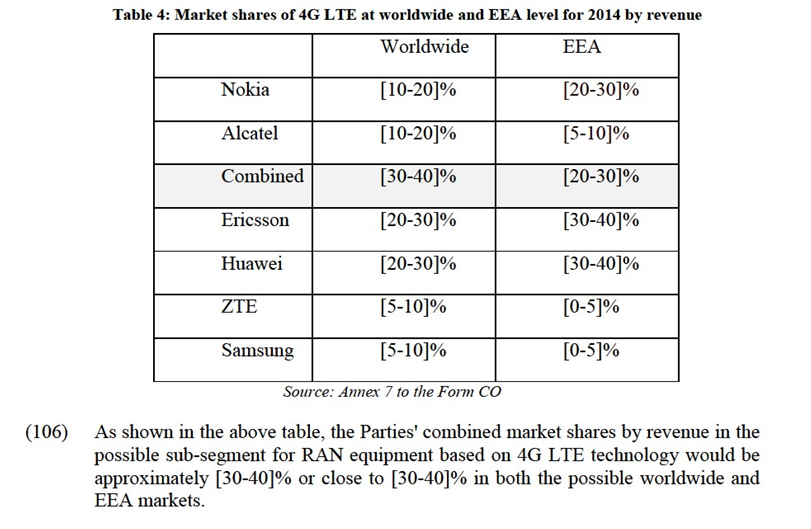
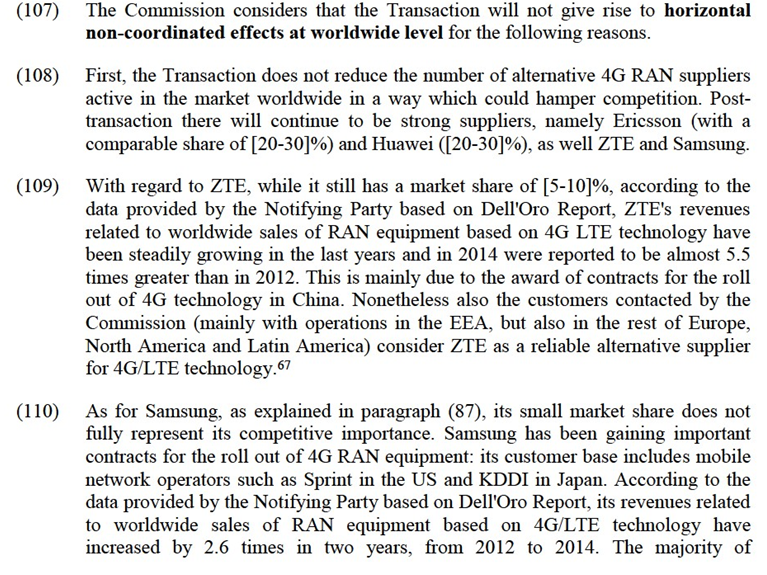
respondents to the market investigation consider Samsung as a reliable alternative supplier having good 4G technology.68
(111) Second, the Parties do not appear to be close competitors for the same reasons explained in paragraphs (88) and (89) above.
(112) In addition, despite the symmetry in market shares between the merged entity, Ericsson and Huawei, the Commission considers that the Transaction does not give rise to horizontal coordinated effects at worldwide level, for the same reasons stated in paragraphs (91)-(93).
(113) Moreover, the Commission considers that the Transaction will not give rise to
horizontal non-coordinated effects at the EEA level for the following reasons.
(114) First, the increment brought by Alcatel to the combined entity market share is limited, Alcatel only adding approximately [5-10]% to Nokia's pre-existing share in the EEA.
(115) Second, the Transaction does not reduce the number of alternative 4G RAN suppliers active in the market in a way which would hamper competition. Other strong players will remain in the market, namely Ericsson and Huawei, which will be respectively the first and second market players, but also Samsung and ZTE for the reasons explained in paragraphs (97) and (98) above.
(116) Third, the Parties do not appear to be close competitors for the reasons explained in paragraph (99).
(117) In addition, despite the symmetry in market shares between the merged entity, Ericsson and Huawei, the Transaction does not give rise to horizontal coordinated effects at EEA level for the reasons discussed in paragraph (100).
(118) Finally, as explained in paragraph (101), virtually all customers replying to the market investigation consider the overall impact of the Transaction on the RAN market to be neutral or positive both at worldwide and EEA level.
(119) In the light of the above, the Commission considers that the Transaction does not raise serious doubts with regard to its compatibility with the internal market in the possible market segment for RAN equipment based on 4G LTE technology, both at EEA level and worldwide.
5.2.2.3.RAN equipment based on 3G technology
(120) As regards the possible market segment for RAN equipment based on 3G technology, the Parties' and their main competitors' market shares are illustrated in the below Table 5.
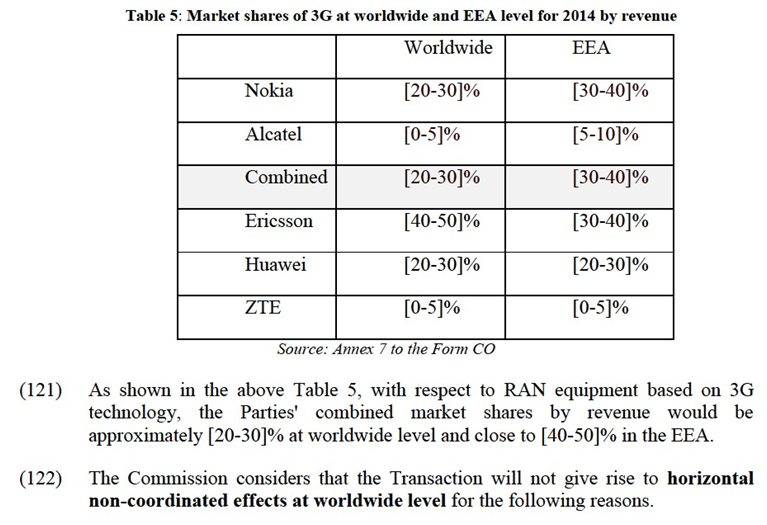
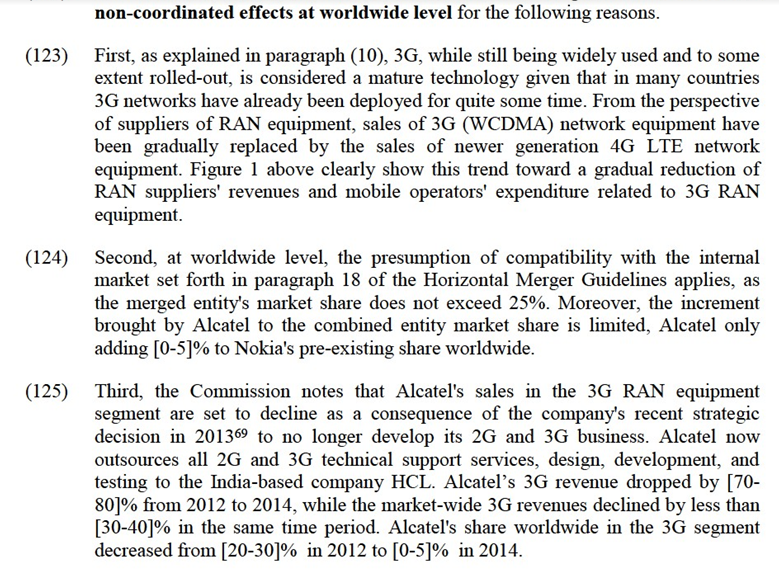
(126) Fourth, in light of Alcatel's above-mentioned strategic decision, the Transaction does not reduce the number of alternative suppliers active in the market for RAN equipment based on 3G technology. Indeed, for the reasons outlined in paragraph (125), Alcatel is not likely to play a significant competitive constraint in the market, so that the competitive landscape would not be significantly changed. Moreover, Ericsson and Huawei have larger market shares worldwide than the merged entity.
(127) In addition, despite the symmetry in market shares between the merged entity, Ericsson and Huawei, the Commission considers that the Transaction does not give rise to horizontal coordinated effects at worldwide level. The Commission acknowledges that the market for RAN equipment based on 3G technology is not particularly innovation driven, given that it is a mature technology. Nonetheless, the Commission also notes that, with regard to mature technologies, deployments have mostly already been completed, and demand for these products in developed geographies, like North America, EEA or Japan, is expected to be limited to maintenance and gap-filling of current networks. As a consequence, sales in relation to mature technologies are expected to be essentially limited to sales to existing customers by the incumbent supplier or small tenders for limited gap-fill projects, and this until the replacement by newer technologies will be completed. In this context, on balance, the Commission considers that even if reaching terms of coordination with respect to the sale of 3G RAN equipment would be possible, for lack of economic incentive, it is unlikely. Given the declining potential revenue (even if higher prices above the competitive level could be set as a result of possible coordinated effort in this direction) that can be derived from a market with diminishing economic significance as the 3G one (especially in comparison with the revenues generated on the 4G market as shown in Figure 1), it does not appear economically rational for market players to engage in coordination. Moreover, horizontal coordinated effects can be excluded for the reasons explained in paragraphs (98) to (99) above.
(128) Moreover, the Commission considers that the Transaction will not give rise to
horizontal non-coordinated effects at the EEA level for the following reasons.
(129) First, as explained in paragraph (123), 3G RAN equipment is a mature technology and RAN suppliers' revenues and mobile operators' expenditure related to its sale are expected to decrease.
(130) Second, the increment brought by Alcatel to the combined entity market share is limited, Alcatel only adding [5-10]% to Nokia's pre-existing share in the EEA.
(131) Third, as explained in paragraph (125), Alcatel's sales in the 3G segment are continuing to decline as a consequence of the company's recent strategic decision to no longer develop its 2G and 3G business.
(132) Forth, as a result of Alcatel's small market presence and cessation of development activity in this market segment, the Transaction does not reduce the number of alternative suppliers active in the market for RAN equipment based on 3G technology in a way which would hamper competition.
(133) Fifth, the Parties do not appear to be close competitors, for the reasons explained in paragraph (99).
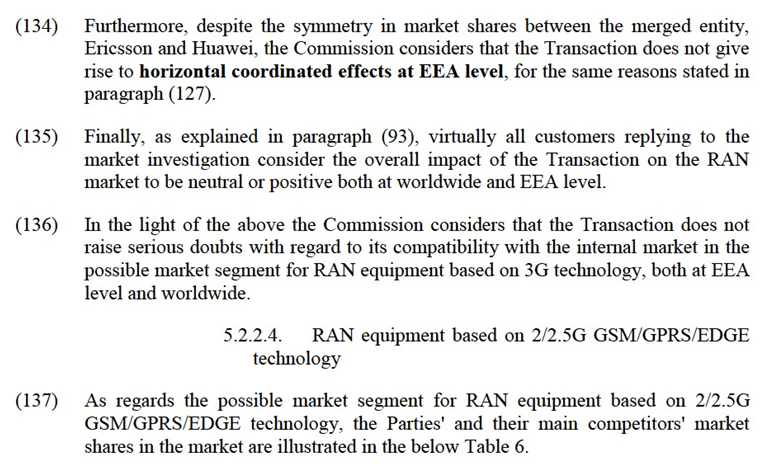
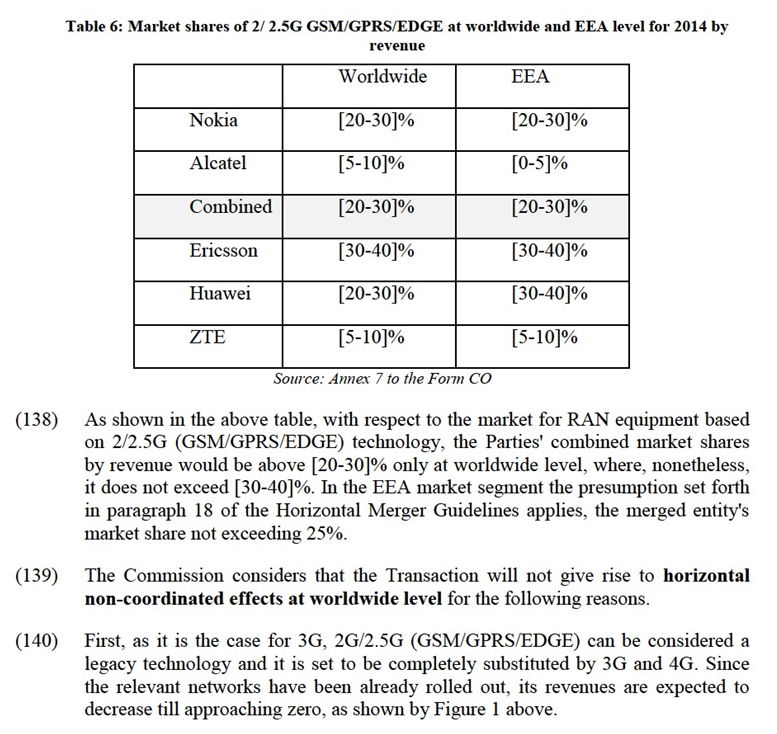
(141) Second, the increment brought by Alcatel to the combined entity market share is limited, Alcatel only adding [5-10]% to Nokia's pre-existing share worldwide.
(142) Third, Alcatel's sales are continuing to decline as a consequence of the company's recent strategic decision to no longer develop its 3G and 2G business, as explained in paragraph (125).
(143) Fourth, the Transaction does not reduce the number of alternative suppliers active in the market for RAN equipment based on 2/2.5G (GSM/GPRS/EDGE) in a way which would hamper competition, as in any event Alcatel has a small market presence and has ceased its development activity in this market segment. Moreover, Ericsson, with a market share of approximately [30-40]%, will remain the clear market leader post-Transaction and also Huawei would keep a significant presence ([20-30]%).
(144) Fifth, the Parties do not appear to be close competitors for the reasons explained in paragraph (99).
(145) In addition, despite the symmetry in market shares between the merged entity, Ericsson and Huawei, the Commission considers that the Transaction does not give rise to horizontal coordinated effects at worldwide level, for the reasons explained in paragraph (127).
(146) Moreover, the Commission considers that the Transaction does not give rise to horizontal non-coordinated effects at EEA level for the same reasons stated in paragraphs (129) to (133)
(147) Furthermore, despite the symmetry in market shares for the merged entity, Ericsson and Huawei, the Commission considers that Transaction does not give rise to horizontal coordinated effects at EEA level, for the same reasons stated in paragraph (127).
(148) Finally, as explained in paragraph (97), virtually all customers replying to the market investigation consider the overall impact of the Transaction on the RAN market to be neutral or positive both at worldwide and EEA level.
(149) In the light of the above the Commission considers that the Transaction does not raise serious doubts with regard to its compatibility with the internal market in the possible market segment for RAN equipment based on 2/2.5G GSM/GPRS/EDGE technology, both at EEA level and worldwide.
5.2.2.5. RAN equipment based on 2G CDMA technology
(150) As regards the possible market segment for RAN equipment based on 2G CDMA technology,70 the Parties' and their main competitors' market shares are illustrated in the below Table 7.
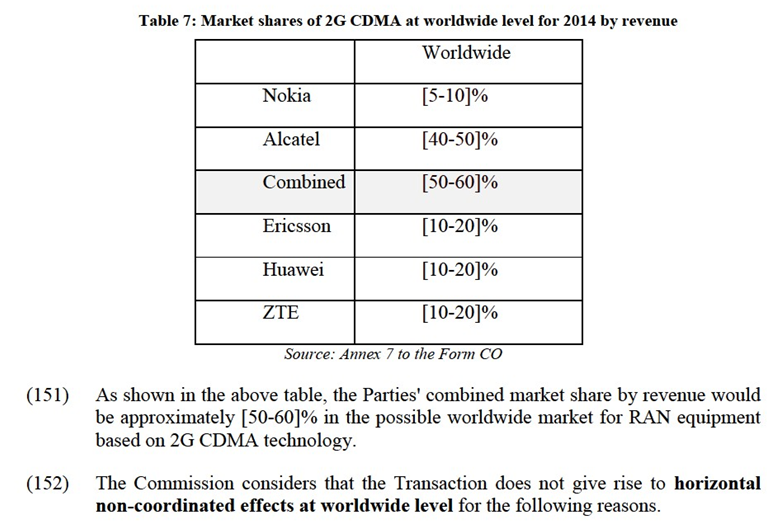
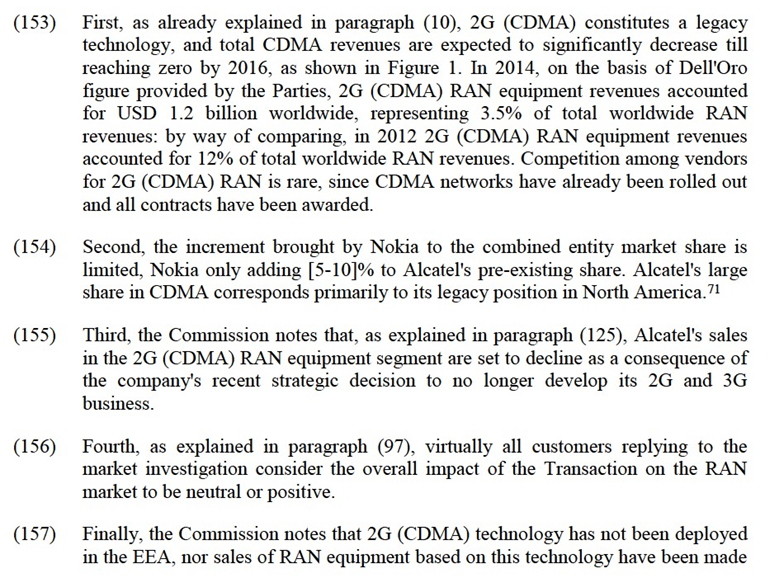
in the recent past, nor are expected in the future, in the EEA. Therefore the impact of the Transaction in the worldwide market for 2G (CDMA) RAN equipment would not affect the internal market.
(158) In the light of the above, the Commission considers that the Transaction does not raise serious doubts with regard to its compatibility with the internal market in the possible market segment for RAN equipment based on 2G CDMA technology worldwide.
5.2.3.Conclusion on RAN
(159) Given the above, the Commission considers that the Transaction does not raise serious doubts with regard to its compatibility with the internal market in the overall market for the supply of RAN equipment, as well as in any of its possible market segments, both in the EEA and worldwide.
5.3.CNS solutions
5.3.1.Notifying Party's view
(160) The Notifying Party claims that the there is a strong ongoing shift in the entire CNS industry from hardware-based technology to software- and cloud-based technology. This shift is accompanied by rapid growth in data traffic with unpredictable traffic patterns resulting in new offerings such as Software Defined Networking ("SDN") technology72 which can be applied to a core network in order to create a virtualized LTE network and Network Function Virtualization ("NFV") which allows the software that historically has been installed on hardware devices to be run on general purpose servers equipped with virtualization software system. According to the Notifying Party these trends enable new entrants that traditionally are software- focused to start competing with the traditional CNS vendors by offering virtualized core products. The Notifying Party claims that the CNS market is characterised by strong competition from a number of other CNS solutions providers and by rapid pace of innovation.
(161) The Notifying Party further submits that the Transaction will allow the Parties to better compete in the CNS solution business in the future and in view of the numerous suppliers that will continue to exercise competitive pressure on the merged entity the Transaction does not give rise to any competition concerns.
(162) As regards Wireless Packet Core products the Notifying Party submits that network operators in general purchase Wireless Packet Core as a complete solution from one vendor. However the Notifying Party notes that due to the standardisation of each of the components of the Wireless Packet Core the operators can purchase the different components from different vendors if they wish to do so for technical or commercial reasons. The Notifying Party also restates its claims that the ongoing industry trend towards virtualization is affecting also the Wireless Packet Core products opening market opportunities for the entry and expansion of new players such as Mavenir or Affirmed Networks to compete with traditional core vendors for the provision of NFV solutions.
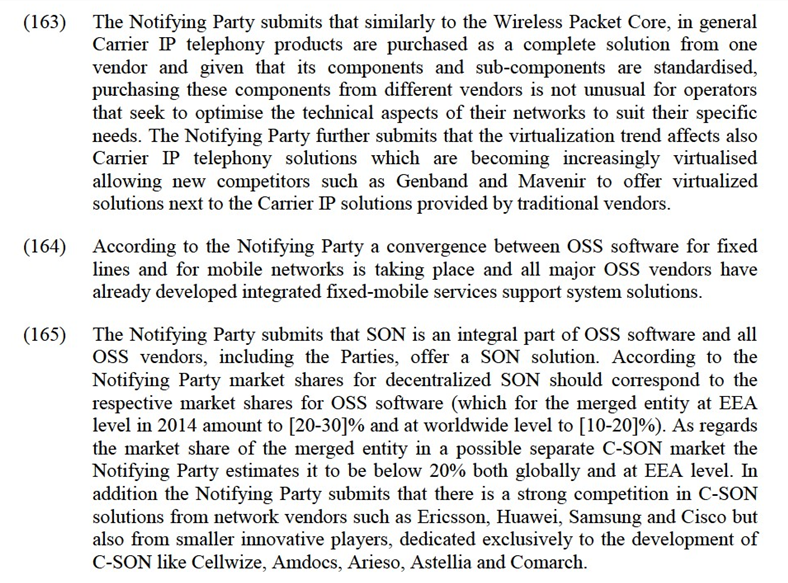
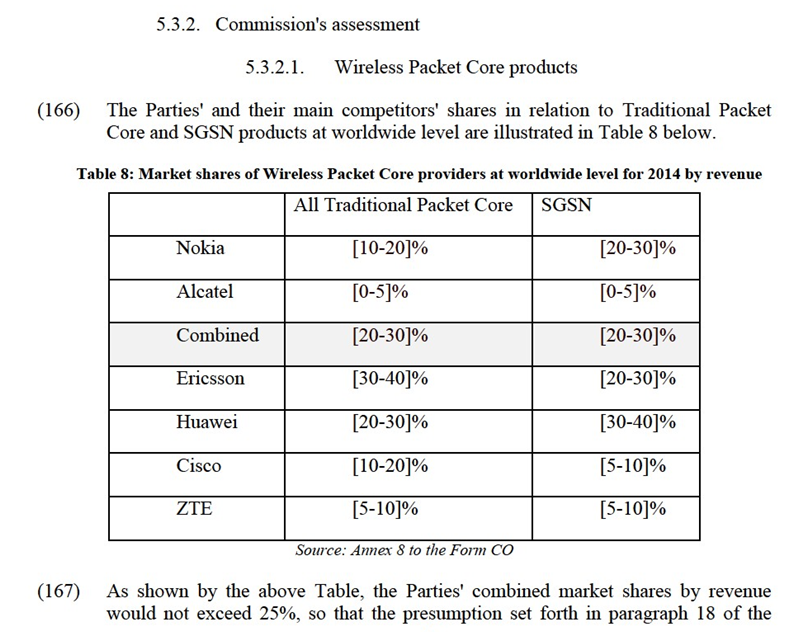
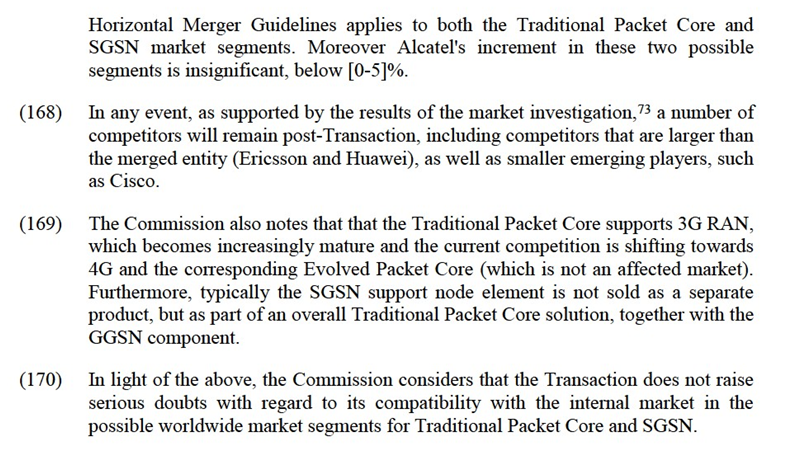
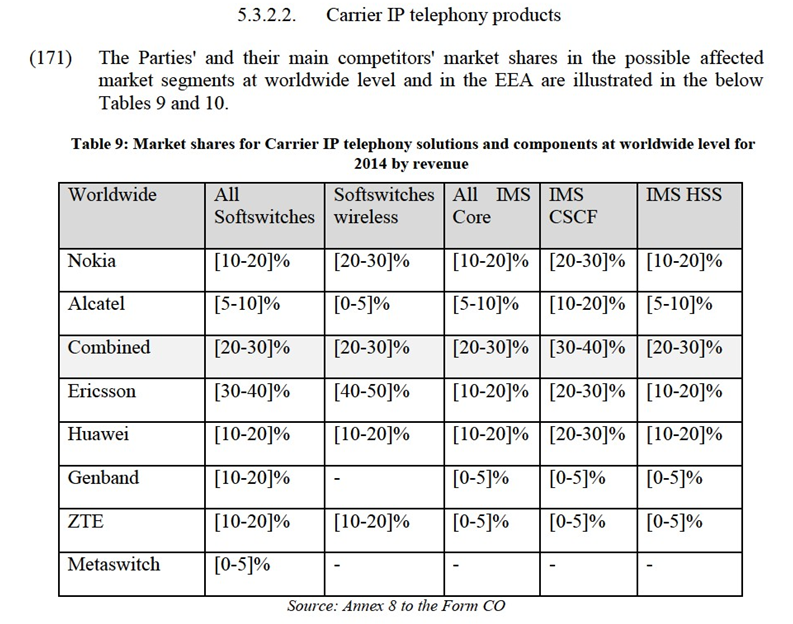
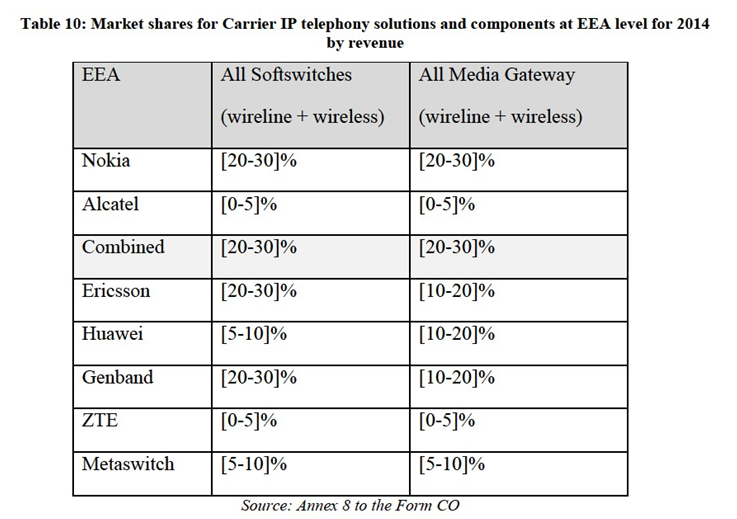
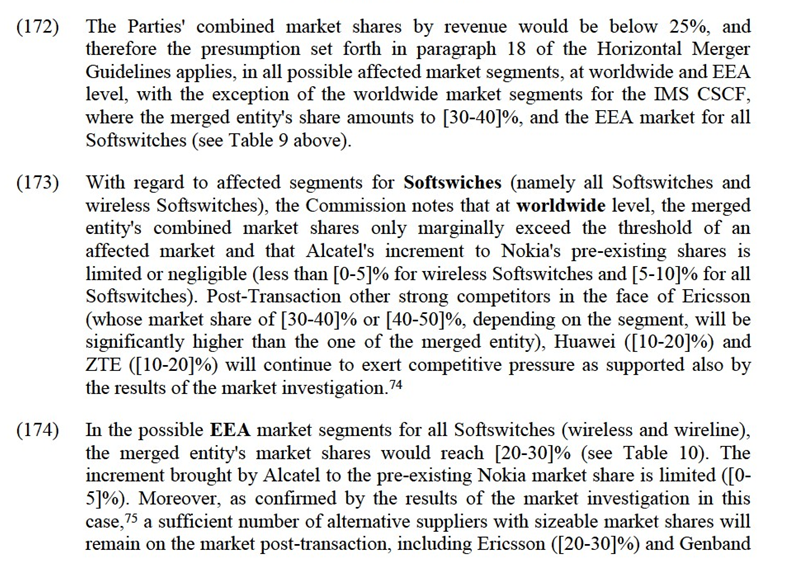
([20-30]%). Finally there is no direct competition between the Parties given that Alcatel's business focus is wireline products, while it is not active with respect to Wireless Softswitches, and viceversa Nokia's business focus is wireless solutions, while it has limited presence in these wireline products.
(175) With respect to the market segment for all Media Gateways (wireless and wireline), the merged entity's market shares would reach [20-30]% in the EEA. The increment brought by Alcatel to the pre-existing Nokia market share is very limited ([0-5]%). Moreover, as confirmed by the results of the market investigation in this case,76 a sufficient number of alternative suppliers with sizeable market shares will remain on the market post-transaction, including Ericsson ([10-20]%), Huawei ([10-20]%) and Genband ([10-20]%). Finally there is no direct competition between the Parties given that Alcatel is not active with respect to wireless Media Gateway components, where Nokia's business is focused, and Nokia has limited presence in these wireline products, where Alcatel's business is concentrated.
(176) As regards IMS Core and its components at worldwide level, the Commission notes that the combined market shares would exceed [20-30]% only with respect to the CSCF component, reaching [30-40]% according to market share data estimated by Dell'Oro. Nonetheless the Commission also notes that IMS Core solutions are typically sold as an integrated product, including both CSCF and HSS components, and that its components are rarely, if at all, sold separately.77 In any event, even with respect to CSCF products, post-Transaction there will remain other alternative providers with sizeable market presence, namely Ericsson ([20-30]%) and Huawei ([20-30]%). Furthermore, the technology change trends towards virtualization and development of IMS Core as an entirely software-based application enable (and will continue to enable) new competitors, not focused on the traditional core equipment, to enter and compete with the merged entity.
(177) In light of the above, the Commission considers that the Transaction does not raise serious doubts with regard to its compatibility with the internal market in the possible market segments for (i) Softswitches at EEA and at worldwide level; (ii) Media Gateway products at EEA level; (iii) Wireless Softswitches at worldwide level; (iv) IMS Core products at worldwide level, including on the possible IMS Core sub-segments CSCF and HSS at worldwide level.
5.3.2.3.OSS solutions
(178) The combined market share of the Parties in the possible affected market for OSS software at EEA level amounts to [20-30]% (Nokia [10-20]%; Alcatel [5-10]%). Therefore, the presumption set forth by paragraph 18 of the Horizontal Merger Guidelines applies.
(179) The Commission considers that the Transaction will not give rise to horizontal non-coordinated effects at the EEA level.
(180) Indeed, large competitors, whose market shares would be higher than the one of the merged entity will remain on the market and will continue to exert significant competitive constraints on the combined entity like Ericsson ([30-40]%) and Huawei ([30-40]%) with ZTE and Samsung also providing a competitive constraint on the merged entity.
(181) The Commission also considers that the Parties' and competitors' OSS software products are largely specific to the equipment which the software operates. As a consequence, the competitive dynamics in relation to OSS software solutions, including closeness of competition or – as concerns the Parties – the lack thereof, follows the competitive dynamics in the respective equipment segments. On this basis, the Parties cannot be considered close competitors.
(182) As explained in paragraphs (43) ff. above, the OSS software is vertically related with C-SON. Both Nokia and Alcatel are OSS vendors and offer C-SON solutions: Nokia's own C-SON offer has some limited multivendor capability, but in Nokia's view it is not fully multivendor,78 while Alcatel has a C-SON solution which is compatible only with its own OSS and is therefore not a multivendor solution. Despite the Parties' market presence at both level of the vertical relationship, no vertically affected market arise as the Parties' combined market shares in all possible relevant market segments would be below [30-40]% (both at worldwide and EEA level).
(183) As explained in paragraphs (43) ff. above, in order to develop a multivendor C- SON solutions both independent C-SON providers and OSS vendors need to be able to use the network status information generated by the network equipment and available via the OSS interfaces. Although the OSS interfaces are in general standardised, certain OSS vendors, among which the Parties, require a feature license in order to allow third-party access and use of a particular kind of network status information in certain interfaces formats. In some cases such "case-specific" licenses could be included in the agreement between the mobile network operator and the provider of the network equipment or could be negotiated after the deployment of the OSS equipment.
(184) In this regard the Commission notes that in 2013 Nokia, jointly with Ericsson and Huawei, established the OSS interoperability initiative ("OSSii") with the aim of cross-licensing access to the respective participants' OSS interfaces on a bilateral basis and of providing a license to any third party on fair, reasonable, and non- discriminatory ("FRAND") terms with respect to OSS interfaces and interoperability test specifications. Through the OSSii interface initiative, the licensee would get access to the specifications and testing facilities of defined Nokia interfaces towards Network Managers and other software that should enable the licensee to develop their product to interface with Nokia's proprietary Network Element Manager. Under this initiative Nokia has granted licences to Ericsson and Huawei and also to Reverb. ZTE decided on 26 May 2015 to co-sign the OSSii agreement and publically committed to the OSSii principles.79
(185) Alcatel on the other hand is not part of the OSSii initiative and any C-SON provider that want to access its OSS interfaces information must negotiate a licence with Alcatel on individual basis. Alcatel provides access to its Network Element Manager via its OSS Connected Partner Program.80 […].
(186) Although the majority of the customers that responded to the Commission's market investigation in this case consider that the Transaction will have no effects on their ability to source C-SON from different suppliers than OSS vendors81 some concerns were voiced as to the effect of the Transaction on the ability of independent vendors to provide C-SON solutions. One particular issue raised by market players is that the licence terms currently offered by Nokia under the OSSii initiative are restrictive in the sense that Nokia is unwilling to allow third party access to certain network information considered to be "real-time" or "near real- time" with less than 15 minutes response cycle thus frustrating the development of more effective C-SON solutions and limiting the attractiveness of C-SON solutions to operators to discourage the adoption of third-party C-SON solutions. Post- transaction Nokia's allegedly more restrictive approach regarding licensing access to this real-time/near real-time data in OSS interfaces format could be extended to Alcatel (which so far was more prone to give access also to these "faster" interfaces) and C-SON providers would be foreclosed from accessing Alcatel's real-time and near-real time interfaces information.
(187) The Commission considers that the Transaction will not give rise to input foreclosure effects for the following reasons.
(188) The Commission recalls that in the present case the vertical relationship between OSS and C-SON does not give rise to any vertically affected markets.
(189) With regard to ability to foreclose, the Commissions notes that, according to the Non-Horizontal Merger Guidelines82 for input foreclosure to be a concern, the vertically integrated firm resulting from the merger must have a significant degree of market power in the upstream market. The Commission notes in this respect that given the actual market shares of the merged entity in the upstream markets for OSS software ([10-20]% at worldwide level and [20-30]% in the EEA) and the number of upstream competitors as mentioned in paragraph (180), the merged entity does not seem to have a significant market power post-Transaction.
(190) Furthermore, the Commission notes that Nokia committed to give access to its OSS interfaces on FRAND terms under the OSSii. If Nokia were to extend its licensing policy to Alcatel's interfaces post-transaction, it will be bound to FRAND terms as per the OSSii initiative commitments also with respect to Alcatel's interfaces. With regard to licences already granted by Alcatel pre-transaction to third party C-SON providers, based on the information available in its file, the Commission considers that the merged entity will not have the ability to unilaterally terminate (or modify) the terms of those licence agreement. […]. Therefore, the merged entity will not have in particular the ability to foreclose third party's access to those of Alcatel's interfaces information which are not covered by the OSSii initiative, if such access has already been negotiated and agreed on a contractual basis pre-Transaction.
(191) Therefore, the Commission considers that the Transaction will not have an impact on Nokia’s ability to foreclose access to its own interfaces. The Commission also considers that the Transaction will also not have any material impact on Nokia’s ability to foreclose access to the Alcatel’s interfaces since third parties having access to these interfaces pre-Transaction will continue to be protected both by their existing agreements and, in any event, by Nokia’s FRAND licensing obligation that will be extended to the Alcatel’s interfaces.
(192) As regards incentives to foreclose, the Commission considers that it is not clear whether the merged entity will have the incentive post-Transaction to foreclose, either completely or partially, access to the data available through certain of Alcatel's OSS interfaces.
(193) As regards the possible foreclosure effects, the Commission also notes that despite certain claims that accessing the real-time and near real-time network status information83 could help C-SON developers to improve the performance of C-SON solutions making them more robust and competitive, it also appears that C-SON solutions could be developed on the basis of the information that is subject to licensing on FRAND terms under the OSSii initiative. Moreover, it is possible that third party C-SON solution developers could source any additional information that they may need directly from the telecom operators.
(194) The Commission also notes that, even if third party C-SON providers were to be somehow foreclosed from accessing certain of Alcatel's interfaces, given the geographic focus of Alcatel's activities for OSS software (Alcatel's market shares at EEA level amount for [5-10]%) the impact of such potential foreclosure in the EEA would be fairly limited.
(195) In light of the above, the Commission concludes that the Transaction does not raise serious doubts with regard to its compatibility with the internal market in the possible market for OSS software at EEA level. The Commission also concludes that no foreclosure effects are likely to arise in relation to access to OSS interfaces information on the possible market segment for C-SON solutions.
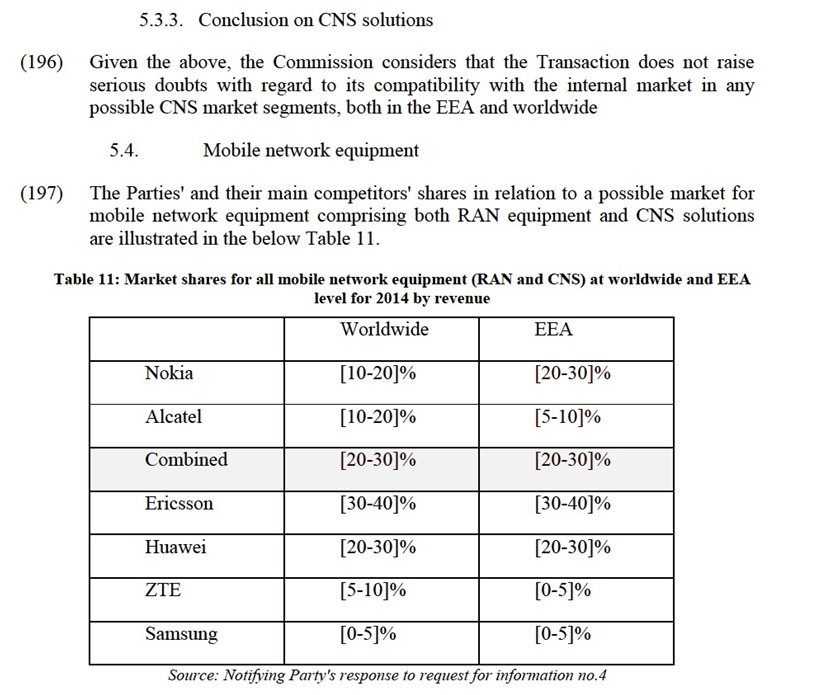
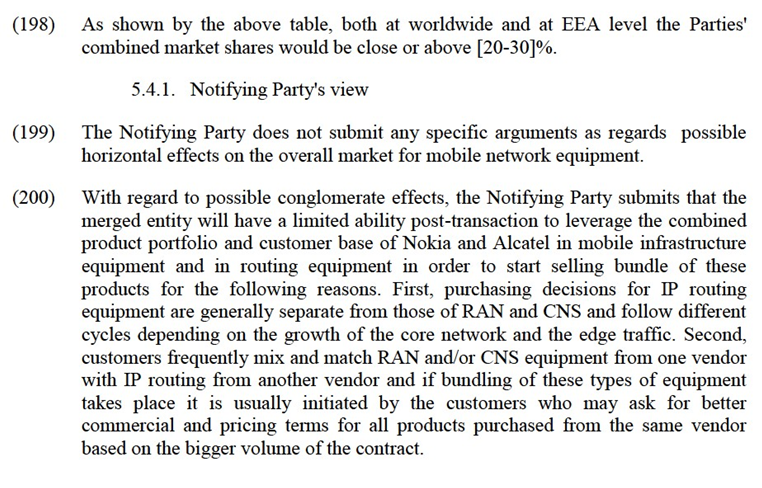
5.4.2.Commission's assessment
(201) The Commission considers that the Transaction will not give rise to horizontal unilateral effects at worldwide or EEA level.
(202) First, the combined market shares are moderate both at worldwide level (combined market share: [20-30]%; Nokia [10-20]% and Alcatel [10-20]%) and at EEA level (combined market share: [20-30]%; Nokia [20-30]% and Alcatel [5-10]%). At EEA level, the presumption set forth by paragraph 18 of the Horizontal Merger Guidelines applies, as the merged entity's market share does not exceed 25%.
(203) Second, both at worldwide and EEA level a sufficient number of mobile equipment vendors will remain active post-Transaction and will continue to exert significant competitive pressure on the merged entity: Ericsson, whose [30-40]% market share (both worldwide and at EEA level) will be higher than the one of the merged entity; Huawei ([20-30]% worldwide and [20-30]% at EEA level); as well as smaller competitors such as ZTE and Samsung. In addition as established already above in Sections 5.2 and 5.3 the Parties are not close competitors neither in RAN equipment nor in the provision of CNS solutions, therefore the Commission considers that Nokia and Alcatel are not close competitors as regards the overall possible market for mobile network equipment either, which mainly consists of RAN equipment and CNS solutions.
(204) One respondent submits that the merged entity thanks to its broader product portfolio post-transaction and its larger customer footprint will increasingly bundle mobile network infrastructure products with routing and switching solutions which would result in increased barriers for smaller vendors with narrower product portfolio to enter and compete in the relevant product markets.
(205) The Commission considers that the Transaction will not give rise to conglomerate effects at worldwide or EEA level as there are no indications that any product bundling undertaken by the merged entity would result in anti-competitive effects.
(206) First, the merged entity will not have a significant degree of market power in the market for mobile network infrastructure equipment, nor in the (sub)markets for RAN equipment and CNS solutions, on the one hand, or in routing and switching solutions,84 on the other hand. Indeed, the Commission has excluded that the merged entity will acquire any significant degree of market power in the markets for mobile network infrastructure equipment, RAN equipment and CNS solutions, respectively in this Section and in Sections 5.2 and 5.3 of this Decision. Moreover, only Alcatel is active in routing and switching solutions and its market share, under any possible product and geographic market definition is never above [20-30]%. Other global providers of routing and switching solutions are Cisco (worldwide market share of [30-40]% and EEA market share of [40-50]%), Juniper (worldwide market share of [20-30]% and EEA market share of [20-30]%) and Huawei (worldwide market share of [10-20]% and EEA market share of [5-10]%).
(207) Second, given the sufficient number of alternative providers for both mobile infrastructure equipment and for routing and switching products the respective products offered by Nokia and Alcatel do not seem to be of particular importance for customers who will still be able to source such solutions from other providers.
(208) Third, based on the available information, the purchasing patterns for mobile infrastructure equipment and for routing and switching products seem to be different since typically RAN and/or CNS solutions are bought in separate tenders from routing and switching, despite the fact that some bundling may occur in the market on request of customers seeking better pricing in exchange for larger volumes of equipment purchased. The Commission notes that even when such bundling of RAN and/or CNS products with routing and switching solutions occurs, it could have pro-competitive effects in the sense that customers could benefit from lower prices for sourcing RAN/CNS and routing and switching solutions as a bundle from the same vendor.
(209) Fourth, in view of the fact that at present Alcatel is already an active provider of RAN equipment and CNS solutions and its respective product portfolio is the same as that of the merged entity, the combined entity would not have an increased ability to bundle RAN and/or CNS products with routing and switching solutions post-Transaction compared to Alcatel's ability in this respect today.
(210) Finally, the main competitors of the Parties today (Ericsson, Huawei and ZTE) are already able to offer RAN, CNS and routing and switching solutions to their customers and the Transaction would not place the merged entity in any position that is more favourable in terms of ability to bundle these types of equipment compared to the ability of existing market players. Already in this pre-Transaction environment, where RAN/CNS provider are able to provide bundle with routing and switching solutions, players such as Juniper and Cisco were able to gain significant market shares in the markets for routing and switching solutions, despite not being integrated in RAN and CNS.
(211) In the light of the above the Commission considers that the Transaction does not raise serious doubts with regards to its compatibility with the internal market in the possible market for mobile network equipment.
5.5. Patents aggregation
(212) Both Nokia and Alcatel hold an important number of patents: Nokia manages a total portfolio of around […] patent families,85 of which approximately […] are considered Standard Essential Patents ("SEPs") and Alcatel's SEPs encompass […] patent families.86 In this Section the Commission assesses the effects of aggregation of Nokia's and Alcatel's patents.
5.5.1.Notifying Party's view
(213) The Notifying Party claims that post-Transaction the merged entity, as a result of its wider patent portfolio, will not have the ability and/or incentive to effectively engage in conduct which could result in the foreclosure of its competitors on the basis of Intellectual Property Rights ("IPR").
(214) The Notifying Party submits that all of Nokia's and Alcatel's SEPs have already been made available for licensing on fair, reasonable and non-discriminatory ("FRAND") terms and the Transaction will not affect in any way the Parties' FRAND commitments.
(215) The Notifying Party further submits that the Transaction will not change Nokia's incentives in respect to patent licensing as Nokia has already been active in the provision of the network infrastructure equipment and will continue to do so post- merger becoming a bigger player with a larger product portfolio.
(216) Finally the Notifying Party submits that all of the merged entity's major competitors will own a comparable or even larger number of patents in the same business area.
5.5.2. Commission's assessment
(217) The Commission considers that the Transaction does not raise serious doubts with regard to its compatibility with the internal market as regards patent aggregation for the following reasons.
(218) First, to the extent that the patents that the merged entity will control are SEPs, such patents are subject to FRAND obligations. FRAND commitments essentially oblige SEP holders to make the patent in question available to all interested third parties, not to discriminate between different licensees and to offer a license on fair and reasonable terms. The merged entity is therefore obliged to license its SEPs to any interested party under such FRAND terms and the Transaction will not affect or change the Parties' FRAND commitments in this regard.
(219) Second, the Commission notes that the merged entity's SEPs portfolio in relation to LTE network equipment (around […] SEPs or approximately [5-10]% of all LTE SEPs declared to ETSI standardization body87) will be by and large of similar size as that of its main competitors (Ericsson with [5-10]% of LTE SEPs declared to ETSI, Huawei with [10-20]%, Samsung with [10-20]% and ZTE with [5-10]%). The merged entity's SEPs portfolio in relation to LTE network equipment will be related to a larger network equipment business downstream (compared to today businesses of Nokia and Alcatel separately) and therefore the merged entity could not be considered a non-practicing entity as claimed by a market player in the market investigation.
(220) Third, the majority of the competitors that took part in the Commission's market investigation in this case do not expect any changes of the licensing policy of Nokia and Alcatel as a result of the Transaction.88 Two respondents however voiced concerns claiming that Nokia is currently an aggressive patent asserter and after the merger Nokia will extend this licensing policy to the Alcatel's patents portfolio by seeking to maximize the royalty payments for Alcatel's patents.
(221) The Commission considers that these claims are not well-substantiated. As regards the SEPs of the merged entity as already explained in paragraph (218) above such patents are under the obligation to be licensed on FRAND terms and these obligations will not change as a result of the Transaction. As regards non-SEPs, first the information gathered during the market investigation does not suggest that, post-Transaction, Nokia would have greater ability and incentive to enforce Alcatel’s non-SEPs than Alcatel has today. Moreover, even if this were to be the case, the information in the Commission’s file does not provide indications that any Nokia/Alcatel non-SEP (whether on a standalone basis or as a thicket) is indispensable for the merged entity’s competitors to compete on the market.
(222) Therefore, the Commission concludes that no foreclosure effects are likely to arise in relation to SEPs and non-SEPs as a result of the Transaction.
(223) In the light of the above the Commission considers that the Transaction does not raise serious doubts with regards to its compatibility with the internal market with respect to patents aggregations.
6.CONCLUSION
(224) For the above reasons, the European Commission has decided not to oppose the notified operation and to declare it compatible with the internal market and with the EEA Agreement. This decision is adopted in application of Article 6(1)(b) of the Merger Regulation and Article 57 of the EEA Agreement.
1 OJ L 24, 29.1.2004, p. 1 ('the Merger Regulation'). With effect from 1 December 2009, the Treaty on the Functioning of the European Union ('TFEU') has introduced certain changes, such as the replacement of 'Community' by 'Union' and 'common market' by 'internal market'. The terminology of the TFEU will be used throughout this decision.
2 OJ L 1, 3.1.1994, p.3 ("the EEA Agreement").
3 Only one Alcatel's shareholder currently owns more than 5% of shares or voting rights.
4 Pursuant to the Memorandum of Understanding, in the event that Nokia owns less than 95% of Alcatel at post-Transaction, it reserves its rights to take other steps necessary to reach 100% ownership of Alcatel.
5 See page 2, Total coverage by technology at EU level 2012-2013 (HSPA indicator – HSPA is a technology built onto existing 3G UMTS and WCDMA technologies to provide increased data transfer speeds) in Digital Agenda Scoreboard 2014 "Broadband markets" presentation at http://ec.europa.eu/information_society/newsroom/cf/dae/document.cfm?doc_id=5810
6 WCDMA and UTMS are the same technology and both acronyms are used interchangeably, particularly in reference to RAN.
7 Neither Nokia nor Alcatel offer WiMAX products.
8 Commission decision in Case M.4297 – NOKIA/ SIEMENS of 13 November 2006.
9 Commission decision in Case M.6007 Nokia Siemens Networks/Motorola Network Business of 15 December 2010.
10 Commission decision in Case M.4297 – NOKIA/ SIEMENS of 13 November 2006, paragraph 19.
11 Commission decision in Case M.4297 – NOKIA/ SIEMENS of 13 November 2006, paragraphs 26 - 29.
12 Commission decision in Case M.6007 Nokia Siemens Networks/Motorola Network Business of 15 December paragraphs 13 and 14.
13 See replies to Q2 - questionnaire to customers, questions 2 and 3.
14 See replies to Q1 – questionnaire to competitors, question 3.
15 See replies to Q2 - questionnaire to customers, question 4.
16 See replies to Q1 – questionnaire to competitors, question 5.
17 See replies to Q2 - questionnaire to customers, question 5.
18 Commission decision in Case M.4297 – NOKIA/ SIEMENS of 13 November 2006, paragraph 48.
19 Commission decision in Case M.6007 Nokia Siemens Networks/Motorola Network Business of 15 December 2010, paragraph 21.
20 See replies to Q2 - questionnaire to customers, question 6.
21 See replies to Q2 - questionnaire to customers, question 6.
22 See replies to Q2 - questionnaire to customers, question 6.
23 See replies to Q1 - questionnaire to competitors, question 8 and 9.
24 See replies to Q1- questionnaire to competitors, question 10.
25 See replies to Q1- questionnaire to competitors, question 12.
26 See replies to Q1- questionnaire to competitors, question 14.
27 Thanks to the full interoperability between RAN and CNS equipment, operators can choose to source RAN and CNS equipment from different vendors. The full interoperability is ensured by the standardisation of the interfaces that handle the communication between the RAN and the CNS.
28 The Traditional Packet Core uses circuit-switching equipment for voice traffic and packet-switching equipment for data traffic, while the Evolved Packet Core treats voice and data traffic as IP traffic.
29 Neither Nokia nor Alcatel offer PDSN or ASN Gateway products.
30 Such sub-component include Gateway GPRS Support Node ("GGSN"), Serving GPRS Support Node ("SGSN"), Packet Data Serving Node ("PDSN") and Access Service Network ("ASN") Gateway for the Traditional Packet Core and Mobility Management Entity ("MME") plus Packet Data Node gateway ("PGW") for the Evolved Packet Core.
31 Carrier IP telephony components include: Softswitch (both wireless and wireline), Media Gateway (both wireless and wireline), Session Border Controller, Voice Application Server (both wireless and wireline), IP Multimedia Subsystem ("IMS") core covering IMS Call Session Control Function ("IMS CSCF") and IMS Home Subscriber Server ("IMS HSS") sub-components.
32 Commission decision in Case M.4297 – NOKIA/ SIEMENS of 13 November 2006, paragraphs 19 and 23.
33 Commission decision in Case M.4297 – NOKIA/ SIEMENS of 13 November 2006, paragraphs 29 and Commission decision in Case M.6007 Nokia Siemens Networks/Motorola Network Business of 15 December 2010, paragraph 14.
34 Commission decision in Case M.4297 – NOKIA/ SIEMENS of 13 November 2006, paragraph 29.
35 The market investigation in Nokia/Siemens revealed that BSS and OSS are different in terms of interchangeability.
36 See replies to Q2 - questionnaire to customers, question 18 and replies to Q1 – questionnaire to competitors, question 26.
37 See replies to Q2 - questionnaire to customers, question 19.
38 See replies to Q2 - questionnaire to customers, question 20.
39 See replies to Q1 – questionnaire to competitors, questions 27 and 28.
40 See replies to Q2 - questionnaire to customers, question 21 and replies to Q1 – questionnaire to competitors, question 29.
41 See replies to Q2 - questionnaire to customers, questions 22 and 23.
42 See replies to Q1 – questionnaire to competitors, questions 30 and 31.
43 See replies to Q1 – questionnaire to competitors, question 32.
44 See replies to Q2 - questionnaire to customers, question 32; replies to Q1 – questionnaire to competitors, question 50 and Q3 – questionnaire to C-SON competitors, question 3.
45 See replies to Q2 - questionnaire to customers, question 33.
46 Commission decision in Case M.4297 – NOKIA/ SIEMENS of 13 November 2006, paragraphs 47, 51 and 54.
47 Commission decision in Case M.6007 Nokia Siemens Networks/Motorola Network Business of 15 December 2010, paragraphs 20 and 21.
48 With respect to Carrier IP telephony a respondent explains that IP is a worldwide standardized technology and therefore there could be no differences on the provided technology around the globe, see replies to Q2 - questionnaire to customers, question 26.
49 See replies to Q2 - questionnaire to customers, questions 25 and 26.
50 See replies to Q1 – questionnaire to competitors, questions 33 and 39.
51 See replies to Q1 – questionnaire to competitors, questions 34 and 40.
52 See replies to Q1 – questionnaire to competitors, questions 35 and 41.
53 Managed services allow an operator to outsource certain tasks to the service provider. Managed service may include (i) technical management of parts of the network; (ii) hosting services and (iii) Build-Operate-Transfer, which includes the construction of a network for an operator, followed by a period of network operation by the service provider, and finally an optional handover to the operator.
54 Parties estimate their market share in HSS to correspond to their overall IMS Core market share.
55 See replies to Q2 – questionnaire to customers, question 8.
56 See replies to Q2 – questionnaire to customers, question 12.
57 See replies to Q2 – questionnaire to customers, question 11.
58 Nokia's internal presentations "Competitive Landscape Q2/14" dated 26 August 2014 and "Competitive landscape Q1/14" dated 23 May 2014.
59 Guidelines on the assessment of horizontal mergers under the Council Regulation on the control of concentrations between undertakings ("Horizontal Merger Guidelines"), Official Journal C 31, 05.02.2004, p. 5-18, paragraph 45.
60 Horizontal Merger Guidelines, paragraph 42.
61 Horizontal Merger Guidelines, paragraph 43.
62 Horizontal Merger Guidelines, paragraph 49.
63 Horizontal Merger Guidelines, paragraphs 52-53.
64 See replies to Q2 – questionnaire to customers, question 13.
65 See replies to Q2 – questionnaire to customers, question 11.
66 See replies to Q2 – questionnaire to customers, question 17.
67 See replies to Q2 – questionnaire to customers question 13.
68 See replies replies to Q2 – questionnaire to customers, question 12.
69 Alcatel’s Press release : Alcatel-Lucent launches « The Shift Plan » to focus on IP networking and ultra-broadbband access (19 June 2013) https://www.alcatel-lucent.com/press/2013/002859.
70 2G CDMA and 2/2.5G GSM/GPRS/EDGE constitute different technologies. In particular, 2/2.5G GSM/GPRS/EDGE is based on completely different basic technology than 2G CDMA and therefore these two technologies are not interoperable, i.e. there are always separated GSM and CDMA networks even if the two technologies are deployed in the same country.
71 2G (CDMA) equipment is primarily used in geographies, such as North-America, China, Japan and South Korea.
72 Software Defined Networking is a new approach to designing, building, and managing networks, that separates the network’s control (brains) and forwarding (muscle) planes to better optimize each.
73 See replies to Q2-questionnaire to customers, question 28 and replies to Q1-questionnaire to competitors, question 46.
74 Ibid
75 See replies to Q2-questionnaire to customers, question 30 and replies to Q1-questionnaire to competitors question 48.
76 See replies to Q2 - questionnaire to customers, question 30 and replies to Q1 – questionnaire to competitors, question 48.
77 The market shares estimated by Dell'Oro for the CSCF component likely misrepresent the actual market shares, as Dell'Oro methodology for calculating these shares consists of estimating the total market for CSCF by removing the total market size for HSS (USD 562.9 million) from the total market size of the IMS Core market (USD 1 732.6 million), obtaining in this way a total CSCF market of USD 1 169.7 million. By contrast, market shares of vendors on the CSCF market are calculated on the basis of their total IMS Core sales without deducting their HSS sales.
78 Nokia has recently acquired in 2015 US Eden Rock which offers a multivendor C-SON solution.
79 http://www.zte.com.cn/cn/banner/doc/201503/t20150324 432494.html
80 https://www.alcatel-lucent.com/osscp
81 See replies to Q2 - questionnaire to customers, question 37.
82 Guidelines on the assessment of non-horizontal mergers under the Council regulation on the control of concentrations between undertakings ("Non-Horizontal Merger Guidelines"), OJ C 265, 18 October 2008, paragraph 35.
83 The Notifying Party claims that using real-time/near real-time interfaces information for traffic steering purposes as part of the C-SON solution operation could overload the network management system, adversely affecting the network performance. […]. These technical limitations to the scope of the interfaces information licensed under OSSii were according to Nokia incorporated in the interest of avoiding the risk of network performance degradation.
84 IP routing equipment referenced covers only so-called Service Provider or SP routers purchased by telecommunication networks providers and excludes smaller, less powerful routers called Enterprise Routers which are not purchased by mobile network equipment customers.
85 Nokia's patents are held and managed by three different business units: Nokia Networks with a portfolio of near 4 000 patent families which include 11 000 granted patents and patent applications (of which around […] are SEPs), Nokia Technologies with approximately 10 000 patent families including 30 000 granted patents and patent applications (of which 1 200 are SEPs) and HERE managing a portfolio of around 700 digital mapping related patent families. Nokia's patent families cover a broad range of domains and technologies: radio […]; networks and services […]; multimedia […]; software […]; hardware […]; maps and location […]; User Interface […].
86 Alcatel-Lucent's patent portfolio consists of approximately 33 000 granted patents and 15 000 pending applications of April 2015.
87 European Telecommunications Standards Institute
88 See replies to Q1 - questionnaire to competitors, question 56.